


NFTs have recently swept the digital world by storm. Because of this, companies from a variety of sectors have been quick to grasp the potential advantages of NFTs. New revenue sources, increased brand involvement, and improved consumer experiences are all advantages. The industries adapting to NFTs are expanding significantly, and this trend is expected to continue for some time. The main industries that have adopted NFTs will be discussed in this article, along with how they are utilizing them.
We will examine particular instances of how NFTs are being employed and the advantageous effects they are having on enterprises, from the realm of art to gaming, sports, fashion, real estate, and charity. This article will provide you insights into the top sectors that have adopted NFTs and how they are using this technology to drive success, whether you are a business owner, investor, or are simply interested in learning more about the world of NFTs.
The emergence of NFTs has heightened the enthusiasm surrounding digital assets, and companies from a variety of industries are beginning to use this technology. NFTs have the power to revolutionize how organizations interact with their consumers and do business, providing distinctive advantages that can help firms stand out in a competitive market.
Why, therefore, are companies using NFTs in the first place? There are several reasons:
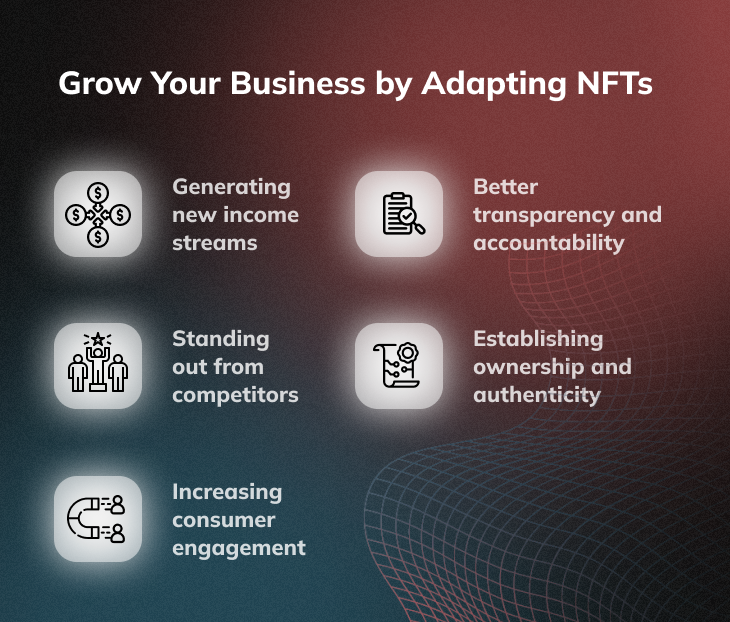
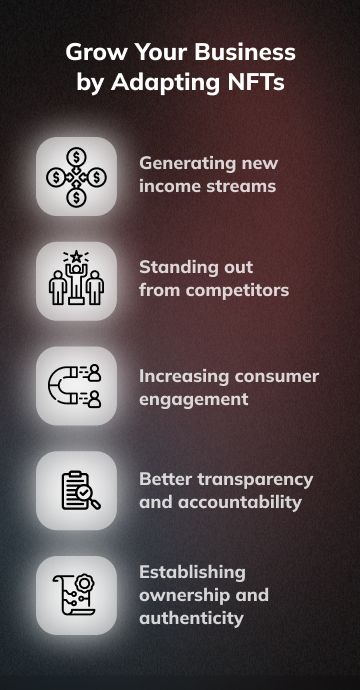
More companies are expected to employ NFTs as their potential applications grow in order to obtain a competitive advantage. According to a report by NonFungible.com, the market for NFTs surged from $30 million in 2017 to $24.7 billion to the end of 2022. This represents a significant growth in the use and adoption of NFTs in various industries.
We will go deeper into each of these justifications and look at instances of how organizations are really use NFTs to accomplish their objectives in the sections that follow. Read on to discover more.
It is not unexpected that the number of industries adapting to NFTs is increasing because many of them understand how revolutionary they can be in the way they do business.
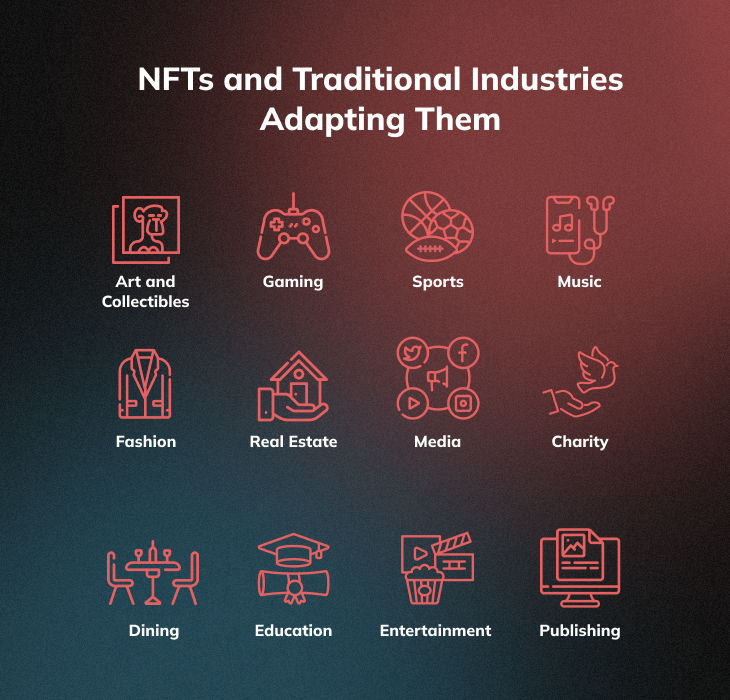

The art and collectibles industries, in particular, have welcomed NFTs because they enable artists to produce and market original digital artworks as one-of-a-kind products. The advantages of NFTs, however, have also been acknowledged by other sectors, including gaming, sports, entertainment, and even charity.
One of the first industries to use NFTs was the art sector, which completely changed how artists create and market digital artwork. Non-fungible tokens, often known as NFTs, are exclusive digital assets that are confirmed on a blockchain. Digital artworks may now be produced and sold by artists as distinctive, one-of-a-kind assets, making it simpler for collectors to confirm ownership and authenticity.
Demand for NFT art has increased as a result of the proliferation of NFTs, which has given artists new ways to make money from their digital creations. The most expensive NFT artwork ever sold was a piece by digital artist Beeple that fetched a record-breaking $69 million at a Christie‘s auction in March 2021. This transaction demonstrated the increasing demand for NFT art and was a crucial turning point for the industry.
Established art institutions have also been interested in the NFT boom, and several museums and galleries are looking for methods to add NFTs to their collections. For instance, the popular NFT collectable CryptoPunks was admitted to the permanent collection of the Museum of Modern Art (MoMA) in New York City in March 2021.
The NFT boom has revolutionized the art world by giving artists new ways to make money off their digital creations, improving market security and transparency, and drawing in new patrons.
The incorporation of NFTs into gaming-related goods and services has received immediate support. Players now have a new market for rare and expensive in-game things that they may purchase and exchange thanks to NFTs. As a result, game developers and publishers have seen an increase in player engagement, retention, and new income sources.
The biggest NFT gaming platform, Axie Infinity, had over 1.4 million daily active players and produced over $1 billion in revenue in July 2021 alone, according to research by DappRadar. This demonstrates the NFTs’ rising appeal in the gaming sector and how they may generate large profits for game publishers and creators.
The game The Sandbox serves as another illustration of NFTs’ success in the gaming sector. The Sandbox raised over $40 million in its inaugural NFT auction in 2020, and in a single week, their virtual land marketplace brought in over $1.5 million.
New employment possibilities, such as those for NFT designers, developers, and market analysts, have also been produced as a result of the integration of NFTs into the gaming business.
Overall, the introduction of NFTs into the gaming sector has been a good thing, since it has the potential to significantly increase income, player engagement, and job possibilities. It is expected that the game industry will continue to develop and adapt to these as NFT use and popularity rise.
NFTs are now being incorporated into sports-related businesses and services. Sports fans now have more ways to collect and own one-of-a-kind digital items that are connected to their favorite teams and athletes thanks to NFTs. Sports organizations might benefit from new income sources and chances for fan interaction if they employ NFTs.
In 2022, sales in the sports NFT market increased by 100% compared to 2021 and reached a total of $2.6 billion. This demonstrates the increasing acceptance of NFTs in the sports sector and their potential to generate large financial gains.
An excellent illustration of how NFTs affect the sports industry is NBA Top Shot. Fans may purchase, sell, and trade unique digital treasures, such as video highlights of their preferred NBA players, on the blockchain-based platform known as NBA Top Shot. There were $2.7 million in sales on the NBA Top Shot platform in October, which was the beginning of the 2022–2023 NBA season.
The first Top Shot Moments with NBA Draft footage are here!
— NBA Top Shot (@NBATopShot) May 23, 2023
Minted to just /75 each, Rookie Revelation features ultra limited edition Legendary collectibles from the 2022 NBA Draft Class.
See the Moment and Join the Drop: https://t.co/mg7iuSZvJL pic.twitter.com/fBCnKTI52L
Fans may buy Moments Packs, which come with a randomly chosen selection of moments, in the marketplace or they can participate in online auctions to bid on specific moments. In order to obtain unique awards and badges, fans may also take part in a variety of challenges and events. NBA fans and collectors are now more engaged and excited than ever because to these events.
NBA Top Shot has also teamed up with a number of NBA clubs and players to provide fans with exclusive opportunities and incentives. These kinds of collaborations and experiences provide fans new ways to connect with content while also generating income for the platform and the sports business.
NFTs have been quickly embraced by the music business as a method to monetise digital material and interact with fans. Fans may purchase special digital items from NFTs, such as songs, albums, and concert tickets. For musicians and their labels, the ability to market these digital assets as distinctive, one-of-a-kind goods has the potential to open up new revenue sources.
The sale of album or song NFTs is one instance of how NFTs are employed in the music business. Electronic artist 3LAU sold an album NFT for $11.7 million, making it one of the priciest NFTs ever sold. The NFT includes limited-edition vinyl, a personalized diamond ring, and unique access to never-before-heard music. This sale demonstrated the potential for NFTs to be used as a new revenue stream for musicians.
The selling of concert tickets is another way that NFTs are employed in the music business. Kings of Leon were the first band to sell concert tickets as NFTs in June 2021, enabling fans to buy one-of-a-kind digital items that also gave them access to the band’s live performance. This creative method of ticketing showed how NFTs may be utilized to engage audiences and offer distinctive experiences.
The value of NFT sales in the music industry has reportedly topped $1.7 billion in 2022, with certain artists realizing sizeable profits from their NFT sales, according to a research by Music Business Worldwide.
This statistic demonstrates the increasing interest in and use of NFTs in the music business as well as the technology’s potential to fundamentally alter how musicians commercialize their digital work and interact with listeners.
The goal of incorporating NFTs into the fashion industry’s business structures is to produce one-of-a-kind digital assets that collectors can purchase and own. NFTs provide users the option to sell exclusive assets that may be owned and sold on blockchain markets.
The development of virtual fashion collections is one instance of how NFTs are applied in the fashion sector. A virtual shoe NFT from fashion label RTFKT Studios was sold for $3.1 million, demonstrating the potential for NFTs to be utilized to produce and market distinctive, digital fashion goods. The NFT made the virtual sneaker a highly desired possession in the realm of virtual fashion by giving the owner exclusive access to it.
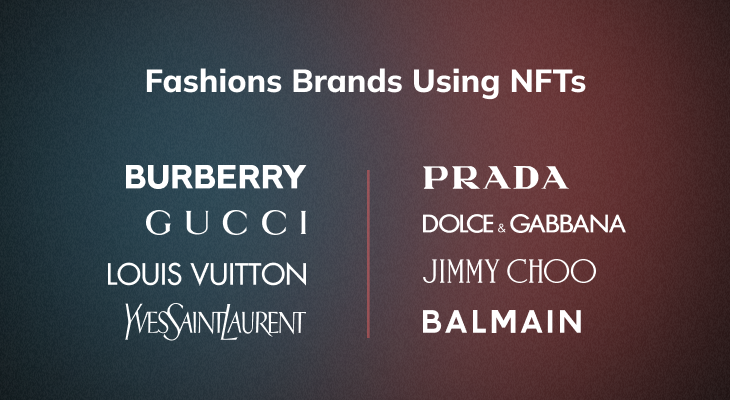
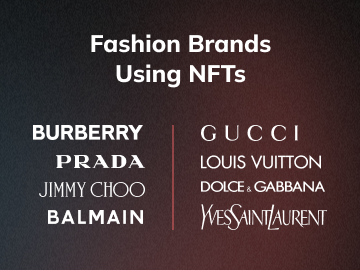
Digital fashion experiences are another way that NFTs are being employed in the fashion sector. For instance, the Italian fashion label Gucci developed “Gucci Aria“, an NFT-based virtual reality experience, in June 2021. The experience, which was a little film showcasing the company’s most recent line, was offered to collectors as an NFT for $25,000. The NFT showcased the potential for NFTs to be utilized as a means to engage customers and create distinctive digital experiences while giving the owner exclusive access to the virtual experience.
The value of NFT sales in the fashion sector has reportedly surpassed $500 million, with certain businesses realizing sizeable profits from their NFT sales, according to a study by Vogue Business. This statistic demonstrates the rising interest in and adoption of NFTs in the fashion sector as well as the potential for this technology to fundamentally alter how firms market and sell their items online.
The possibility of NFTs as a means of developing distinctive digital assets for buildings has been investigated by the real estate sector. Real estate businesses may create a new kind of digital ownership by converting properties into NFTs, giving their customers exclusive access to the property and enabling them to sell it on blockchain exchanges.
The selling of a virtual image of a Miami Beach property is one instance of how NFTs are employed in the real estate sector. Developer of real estate Michael Levy offered for sale as an NFT a digital replica of his $65 million Miami Beach property. The NFT gave the customer a one-of-a-kind digital asset that reflected ownership of the property and gave them access to exclusive events and parties.
The development of options for fractional ownership is another way that NFTs are employed in the real estate sector. Multiple owners can each own a digital interest in a piece of property by using NFTs to represent that fraction of the real estate. This may make it simpler for people to invest in homes they would not otherwise be able to afford, democratizing access to real estate investment options.
The usage of blockchain technology and NFTs in the real estate sector is anticipated to increase over the next several years, with the potential to open up new investment options and simplify the purchasing and selling process, according to a Deloitte analysis. The research also emphasizes how NFTs may be utilized to speed up the transfer of property ownership and confirm the validity of real estate titles.
NFTs give a fresh method for the real estate sector to produce distinctive digital assets and grant restricted access to properties. Future applications of NFTs in the real estate sector are probably going to be more creative as technology develops.
The use of NFTs in the eating sector is now being investigated as a means to develop distinctive dining experiences and reward devoted patrons. Restaurants and food businesses may develop a novel kind of digital asset that provides exclusive access to distinctive culinary experiences and can be traded on blockchain markets by converting dining experiences into NFTs.
The sale of digital versions of expensive wines is one instance of how NFTs are employed in the restaurant business. The Napa Valley winery Alpha Omega offered purchasers a one-of-a-kind digital asset that signified ownership of the rare wine and granted access to special wine tasting experiences and events when they purchased digital representations of rare wines as NFTs.
Loyalty programs are another way that NFTs are utilized in the restaurant sector. Restaurants and food businesses may utilize NFTs to offer exclusive access to eating opportunities, discounts, and other benefits to devoted patrons. Restaurants may develop a new kind of loyalty program that offers clients more value and promotes repeat business by developing digital assets that signify unique access to these benefits.
The usage of NFTs in the eating industry is still in its early stages, but it has the potential to fundamentally alter how the sector approaches loyalty programs and consumer engagement, according to a study by Nation’s Restaurant News. The research also emphasizes how NFTs may be utilized to confirm the legitimacy of rare or unique food products, such as truffles or caviar.
In case if Dining Industry NFTs provide a fresh method for the eating sector to produce distinctive digital assets and grant privileged access to dining experiences. Future applications of NFTs in the restaurant sector are likely to be more creative as long as technology keeps developing.
The media sector is beginning to investigate the usage of NFTs as a means of producing original content and making money off of it on blockchain markets. Media businesses may develop a new kind of digital asset that gives exclusive access to distinctive content and the opportunity to sell it on blockchain markets by converting digital media assets into NFTs.
The selling of digital artwork and memorabilia is one way that NFTs are employed in the media sector. Media businesses like TIME magazine have offered NFTs of their classic magazine covers, giving customers access to special events and experiences while also representing ownership of the iconic magazine cover.
It is with great pleasure to announce #TIMEPieces, a new #NFT community & initiative from @TIME featuring original works by more than 40 artists!
— Keith A. Grossman 🟣 (@KeithGrossman) September 22, 2021
The work! https://t.co/sQ7aaRwR5w
The NFT Drop (9/23 @ noon ET): https://t.co/YkgLPQ0rcR
To learn more: https://t.co/idOc0nlQBO pic.twitter.com/GM8S9iiIRd
The production of original digital content is another way that NFTs are being employed in the media sector. Media businesses can produce NFTs with unique material that fans can buy and own, such as behind-the-scenes video or celebrity interviews. Media firms may monetise their material in novel ways and provide fans with a distinctive method to interact with their preferred media brands by developing digital assets that represent exclusive access to this content.
The usage of NFTs in the media industry is still in its infancy, but it has the potential to fundamentally alter how the sector monetizes its content and interacts with fans, according to research by MediaPost. The research also emphasizes how NFTs may be utilized as a way of to verify the authenticity of digital media assets, such as photographs or videos.
These are new methods for the media sector to produce distinctive digital assets and grant restricted access to material. Future applications of NFTs in the media sector are probably going to be more creative as the technology develops.
A developing trend that enables non-profits to generate money in fresh and creative ways is the usage of NFTs in the charitable sector. Through the usage of NFTs, charities have a special chance to generate digital assets that can be sold on blockchain markets, with the money raised going to support their causes.
The selling of digital artwork is one way that NFTs are employed in the nonprofit sector. Charities can produce NFTs of distinctive digital art, with all sales revenues going to the organization. For instance, the singer Grimes raised nearly $6 million when she sold a collection of NFTs, with a percentage of the money going to organizations that support carbon offsets.
The development of original digital experiences is another way that NFTs are employed in the nonprofit sector. NFTs that symbolize exclusive access to occasions or encounters, such celebrity meet-and-greets or VIP entry to charity events, can be made by charities. Charities may generate money in a fresh and creative way by developing digital assets that represent unique access to these events.
In the charity sector, the usage of NFTs has the potential to transform how non-profits generate money and interact with their supporters, claims a research by Nonprofit Quarterly. The study also emphasizes the requirement for charities to be open about how they utilize NFTs and how the sales earnings are applied to their cause.
In general, NFTs provide organizations with a creative approach to generate money and interact with their fans. Future applications of NFTs in the charity sector are probably going to be more creative as technology advances.
With artists, celebrities, and media firms all investigating the use of digital assets to communicate with audiences and monetize their material, the entertainment sector has been quick to embrace the promise of NFTs.
The production of distinctive digital collectibles is one way that NFTs are applied in the entertainment sector. For instance, the American rock band Kings of Leon offered fans the chance to acquire a limited-edition digital record along with special artwork and other digital assets when they purchased the band’s most recent album as an NFT. Similar to this, well-known EDM performer Deadmau5 has made a number of NFTs that reflect original digital artwork and audio snippets.
The production of virtual worlds and experiences is another way that NFTs are employed in the entertainment sector. The usage of NFTs to provide distinctive digital experiences for fans is being investigated by media corporations like Disney and Warner Bros. NFTs might signify access to virtual events, premium products, and other digital assets.
Grand View Research estimates that the worldwide NFT market would expand to $19.4 billion by 2027, with the entertainment sector serving as a significant development engine. In addition to providing fans with a new method to interact with their favorite artists, the research underlines the potential for NFTs to open up new revenue sources for creatives including <a href=”#music”>musicians</a>, <a href=”#art”>artists</a> and <a href=”#media”>media franchises</a>.
Overall, the entertainment sector is one of the industries adapting to NFTs which improve their approach to interact with fans and monetise their material. More creative applications of NFTs in the entertainment sector are probably on the horizon as technology advances.
NFTs are also beginning to become part of business models in the education sector. NFTs can offer a special technique to confirm the validity of diplomas and other educational qualifications. Academic credentials cannot be faked or forged because to the blockchain technology powering NFTs, which may be advantageous for both students and employers.
Gamification is another way that NFTs are being used in education. NFTs are being used by educators to power instructional games and tests. As a reward for finishing assignments, reaching academic milestones, or developing certain abilities, students might receive NFTs. The ability to gather and exchange these NFTs among students fosters competitiveness and engagement.
The story of a university in Malta that gave its graduates credentials based on the blockchain serves as an illustration of NFTs in the education sector. The certifications were given as NFTs, making it simple for prospective employers or other academic institutions to verify them. This did away with the requirement for laborious background checks or verification procedures.
Another illustration is the “Mintable” NFT-based educational platform, which enables educators to produce and market NFTs that stand in for distinctive educational materials like lesson plans, photos, or videos. These open market-tradable NFTs give educators a new source of income and a means to commercialize their instructional output.
A poll by the Global Blockchain Business Council found that 57% of participants thought that blockchain technology, particularly NFTs, will have a big influence on the education sector. We may anticipate seeing more cutting-edge uses of this technology in the years to come as more educators and institutions start to see the benefits of NFTs in education.
NFTs have already made a significant impact on industries adapting to NFTs and are continuing to gain popularity among businesses of all sizes. As we have seen, NFTs have revolutionized the way industries like art, gaming, sports, and fashion conduct their business and engage with their customers.
The adoption of NFTs is expected to grow exponentially in the coming years. According to a report by NonFungible.com, the NFT market grew by over 299% in 2020, with a total market value of $250 million. This growth is projected to continue, with the market value of NFTs expected to reach around $800 billion by the end of 2024.
As more businesses realize the potential of NFTs to enhance their revenue streams and improve customer engagement, we can expect to see even more industries adapting to this technology. From real estate to education, the possibilities for NFTs are endless.
In conclusion, businesses that want to stay ahead of the curve should seriously consider integrating NFTs into their operations. As the market continues to grow, those who fail to adapt may risk falling behind. With the potential for increased revenue and customer engagement, it’s clear that NFTs are not just a passing fad but rather a game-changing technology that businesses can leverage to their advantage.
Whether it is art, fashion, sports, gaming, or any other industry, NFTs have opened new avenues for growth and innovation. They have developed a decentralized and secure mechanism for the ownership and transfer of digital assets by utilizing the power of blockchain technology.
If you want to learn more how NFTs are changing various sectors check out for interesting facts bellow.
By bringing in new income streams, raising fan engagement, and enhancing asset ownership and management, NFTs are revolutionizing how many sectors conduct business. By 2030 is expected the global non-fungible token market size to be 211.72 billion.
NFTs are being used by businesses in the gaming, sports, fashion, media, and charity. NFTs are being used in several sectors to increase participation, provide exclusivity, and create revenue streams. One of the biggest NFT markets, for instance, is the NBA Top Shot. Brands like Gucci and RTFKT Studios are employing NFTs to offer virtual fashion items.
Businesses in a variety of industries might profit from NFTs. An artist may sell a one-of-a-kind digital piece of art as an NFT, while a sports club might offer supporters limited-edition NFT souvenirs. A fashion firm may utilize NFTs to validate the authenticity of a premium item, and a musician might offer exclusive rights to a song as an NFT.
There many reasons for businesses to be interested in NFTs, including the potential to develop valuable, distinctive digital assets, boost brand recognition, and connect customers in novel ways. NFTs give businesses a new source of income and give them a tool to monetize previously difficult-to-monetize digital material.
Some companies using NFTs include luxury fashion brands like Gucci, sports organizations like the NBA, music labels like Universal Music Group, art galleries like Christie’s, and gaming companies like Ubisoft. These companies are using NFTs in various ways, such as creating unique digital artwork, selling digital collectibles, and offering exclusive experiences.